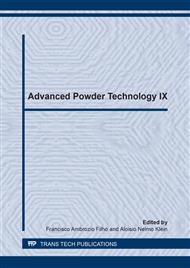p.41
p.46
p.51
p.56
p.61
p.66
p.72
p.78
p.84
Synthesis of TiFe Compound from Ball Milled TiH2 and Fe Powders Mixtures
Abstract:
TiFe compound was produced by high-energy ball milling of TiH2 and Fe powders, followed by heating under vacuum. TiH2 was used instead of Ti in order to avoid the strong particles adhesion to grinding balls and vial walls. Mixtures of TiH2 and Fe powders were dry-milled in a planetary mill for times ranging from 5 to 40 hours. The amount of sample, number and diameter of the balls were kept constant in all experiments. After milling, samples were heated under dynamic high-vacuum for the synthesis reaction. As-milled and heat-treated materials were characterized by X-ray diffraction (XRD), scanning electron microscopy (SEM) and differential thermal analysis (DTA). The mean crystallite sizes and microstrains were determined by XRD line profile analysis using the Warren-Averbach method. As-milled materials presented only Fe and TiH2 phases. Nanostructured TiFe compound was formed after heat treatment. TiH2 was effective for providing low adherence of the powders during milling.
Info:
Periodical:
Pages:
61-65
Citation:
Online since:
December 2014
Keywords:
Price:
Сopyright:
© 2014 Trans Tech Publications Ltd. All Rights Reserved
Share:
Citation:


